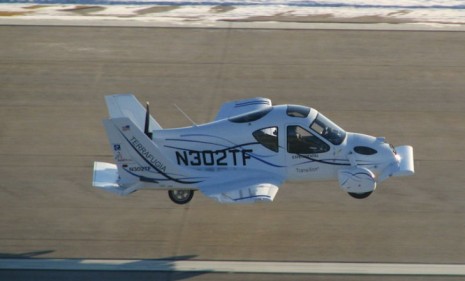How soon will we have flying cars?
Terrafugia, a company that manufactures "roadable aircrafts," scores government approval to make vehicles of the future a reality

In 1989's Back to the Future Part II, Michael J. Fox travels in a DeLorean to the year 2015, when flying cars and hoverboards are the norm. Now, in 2011, that sci-fi fantasy is looking like it could one day be a reality... sort of. Terrafugia, the company that developed the Transition flying car, is one step closer to making its futuristic product available to the public. How does the Transition work, and when might it hit the market? Here, a brief guide:
There's really a car that can fly?
The Transition is more accurately called a "roadable aircraft." It's a multi-purpose vehicle that can drive on the highway and take off on the runway. Its wings fold up neatly on its sides when its not in flight, allowing it to fit in a standard road lane while driving. (See it in action.) The Transition has been in planning stages for more than five years, and has been seeking approval from the Federal Aviation Administration and the National Highway Traffic Safety Administration.
The Week
Escape your echo chamber. Get the facts behind the news, plus analysis from multiple perspectives.

Sign up for The Week's Free Newsletters
From our morning news briefing to a weekly Good News Newsletter, get the best of The Week delivered directly to your inbox.
From our morning news briefing to a weekly Good News Newsletter, get the best of The Week delivered directly to your inbox.
What's the holdup?
For one thing, the windshield specifications don't meet normal automobile standards, so Terrafugia needed special exemptions from the NHTSA before it makes the vehicle commercially available. The laminated safety glass ordinarily required for cars' windshields would be too heavy for an aircraft, and could easily crack, obscuring the pilot's view. The company needed special approval to use a more lightweight polycarbonate windshield, which, as a bonus, can "withstand impacts with birds," says Jonathan Welsh at The Wall Street Journal.
Anything else?
Indeed. There was also a conflict over wheels, as the NHTSA needed to give Terrafugia an exemption to use tires required by the FAA to withstand the impact of landings. Last year, the FAA also granted permission for the Transition to weigh 110 pounds more than is normally allowed for "light sport aircraft," says Nic Halverson at Discovery News.
A free daily email with the biggest news stories of the day – and the best features from TheWeek.com
When will this flying contraption be available?
Now that it's received the special exemptions, Terrafugia said it expects to begin delivering the first few Transition vehicles late next year.
How much would it cost?
The car of the future carries a hefty price tag. The price for the "casual motorist" is expected to be $250,000. And that's not the only thing that could turn off potential customers: The Transition's maximum load is only 330 pounds, says Antony Ingram at All Car Tech.
So, "watch out, George Jetson"?
Not quite. Inevitably, commuters are hearing this news and fantasizing about being able to beat rush hour traffic "simply by flying over it," says Unthinkable. But that may not be entirely plausible. The Transition does need a runway to take off and land on, after all. The biggest advantage of the car may be the ability to drive to an airport and then immediately take off. Unless you happen to live on a quiet road. Then "you could really impress the kids if they're fans of Chitty Chitty Bang Bang."
Sources: All Car Tech, Digital Trends, Discovery News, Unthinkable, Wall Street Journal
-
 The biggest astronomy stories of 2025
The biggest astronomy stories of 2025In the spotlight From moons, to comets, to pop stars in orbit
-
 The 8 best comedy movies of 2025
The 8 best comedy movies of 2025the week recommends Filmmakers find laughs in both familiar set-ups and hopeless places
-
 ‘Care fractures after birth’
‘Care fractures after birth’instant opinion Opinion, comment and editorials of the day